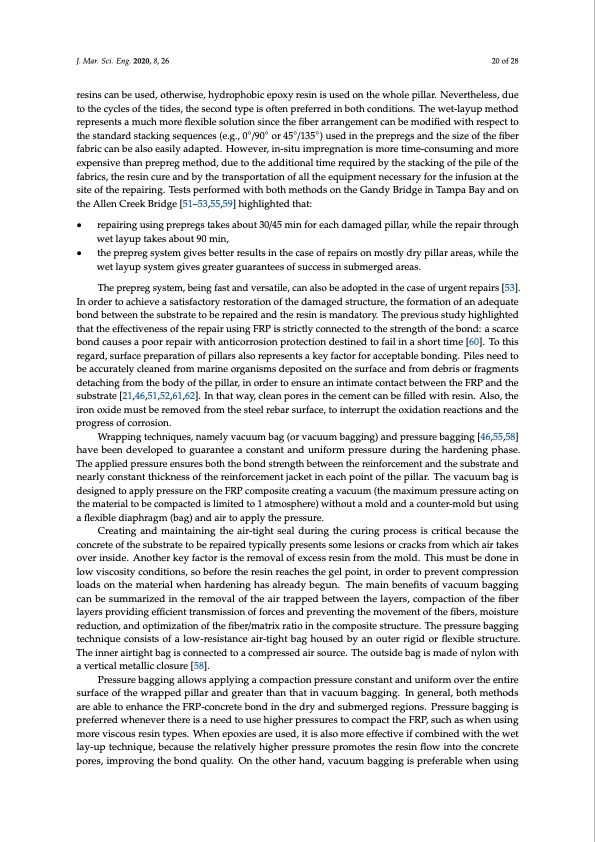
PDF Publication Title:
Text from PDF Page: 020
J. Mar. Sci. Eng. 2020, 8, 26 20 of 28 resins can be used, otherwise, hydrophobic epoxy resin is used on the whole pillar. Nevertheless, due to the cycles of the tides, the second type is often preferred in both conditions. The wet-layup method represents a much more flexible solution since the fiber arrangement can be modified with respect to the standard stacking sequences (e.g., 0◦/90◦ or 45◦/135◦) used in the prepregs and the size of the fiber fabric can be also easily adapted. However, in-situ impregnation is more time-consuming and more expensive than prepreg method, due to the additional time required by the stacking of the pile of the fabrics, the resin cure and by the transportation of all the equipment necessary for the infusion at the site of the repairing. Tests performed with both methods on the Gandy Bridge in Tampa Bay and on the Allen Creek Bridge [51–53,55,59] highlighted that: • repairing using prepregs takes about 30/45 min for each damaged pillar, while the repair through wet layup takes about 90 min, • the prepreg system gives better results in the case of repairs on mostly dry pillar areas, while the wet layup system gives greater guarantees of success in submerged areas. The prepreg system, being fast and versatile, can also be adopted in the case of urgent repairs [53]. In order to achieve a satisfactory restoration of the damaged structure, the formation of an adequate bond between the substrate to be repaired and the resin is mandatory. The previous study highlighted that the effectiveness of the repair using FRP is strictly connected to the strength of the bond: a scarce bond causes a poor repair with anticorrosion protection destined to fail in a short time [60]. To this regard, surface preparation of pillars also represents a key factor for acceptable bonding. Piles need to be accurately cleaned from marine organisms deposited on the surface and from debris or fragments detaching from the body of the pillar, in order to ensure an intimate contact between the FRP and the substrate [21,46,51,52,61,62]. In that way, clean pores in the cement can be filled with resin. Also, the iron oxide must be removed from the steel rebar surface, to interrupt the oxidation reactions and the progress of corrosion. Wrapping techniques, namely vacuum bag (or vacuum bagging) and pressure bagging [46,55,58] have been developed to guarantee a constant and uniform pressure during the hardening phase. The applied pressure ensures both the bond strength between the reinforcement and the substrate and nearly constant thickness of the reinforcement jacket in each point of the pillar. The vacuum bag is designed to apply pressure on the FRP composite creating a vacuum (the maximum pressure acting on the material to be compacted is limited to 1 atmosphere) without a mold and a counter-mold but using a flexible diaphragm (bag) and air to apply the pressure. Creating and maintaining the air-tight seal during the curing process is critical because the concrete of the substrate to be repaired typically presents some lesions or cracks from which air takes over inside. Another key factor is the removal of excess resin from the mold. This must be done in low viscosity conditions, so before the resin reaches the gel point, in order to prevent compression loads on the material when hardening has already begun. The main benefits of vacuum bagging can be summarized in the removal of the air trapped between the layers, compaction of the fiber layers providing efficient transmission of forces and preventing the movement of the fibers, moisture reduction, and optimization of the fiber/matrix ratio in the composite structure. The pressure bagging technique consists of a low-resistance air-tight bag housed by an outer rigid or flexible structure. The inner airtight bag is connected to a compressed air source. The outside bag is made of nylon with a vertical metallic closure [58]. Pressure bagging allows applying a compaction pressure constant and uniform over the entire surface of the wrapped pillar and greater than that in vacuum bagging. In general, both methods are able to enhance the FRP-concrete bond in the dry and submerged regions. Pressure bagging is preferred whenever there is a need to use higher pressures to compact the FRP, such as when using more viscous resin types. When epoxies are used, it is also more effective if combined with the wet lay-up technique, because the relatively higher pressure promotes the resin flow into the concrete pores, improving the bond quality. On the other hand, vacuum bagging is preferable when usingPDF Image | Marine Application of Fiber Reinforced Composites

PDF Search Title:
Marine Application of Fiber Reinforced CompositesOriginal File Name Searched:
jmse-08-00026.pdfDIY PDF Search: Google It | Yahoo | Bing
Development of a solar powered Electric Ship The Electricship website originally started off as a project to develop a comprehensive renewable, affordable, modular electric ship... More Info
Modular Boat Hull Composite The case for a unsinkable, modular composite hybrid boat hull... More Info
MS Burgenstock Hybrid Electric Catamaran Lake Lucerne Unique shuttle servicing Lucerne to the Burgenstock Resort... More Info
Ground Power Unit GPU Powered by Lithium Ion Batteries The goal of the Ground Power Unit is to provide a readily accessible, modular, ready-to-power solution for remote power... More Info
| CONTACT TEL: 608-238-6001 Email: greg@electricship.com | RSS | AMP |